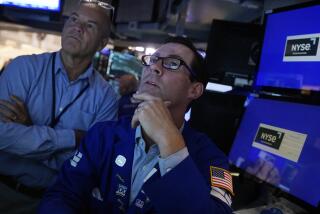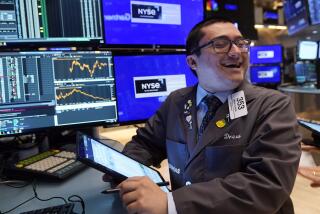Column: U.S. stocks were cruisin’ for a bruisin’ even before Monday’s China rout
We’re usually skeptical of stock market analyses that tie a single day’s action to a single event; they generally look like efforts to impose a single, inevitably artificial rationale on an artifact of millions of individual decisions based on a multitude of reasons. Drawing conclusions about long-term market trends from a single day’s share prices is a mug’s game, anyway. As J. Pierpont Morgan habitually replied when asked what the market would do: “It will fluctuate.”*
That’s true of Monday’s battering. As we write (midday on Wall Street), the Dow Industrials, S&P 500, and Nasdaq index are all down about 2%. The rout is being attributed almost universally to a big drop (7%) in Chinese shares overnight, which in turn was attributed to signs of a sharp slowdown in that country’s economy.
The FANG stocks have served as the shiny baubles distracting everyone from the new sub rosa bear that’s taken hold of the market.
— Josh Brown, investment analyst
A secondary factor being widely bruited about is the emerging confrontation in the Middle East between Saudi Arabia and Iran, which has led to a spike in oil prices. This is curious, since it was the relentless decline in oil prices in the latter part of 2015 that was supposedly weighing on the stock market.
In truth, however, the stock market seldom suffers a slide of this magnitude unless more is going on than a discrete event. Sharp breaks in stock prices -- and sudden run-ups, too -- tend to reflect deeper realities or longer trends that are finally getting washed out over a period of a day, or a week, or longer.
See the most-read stories this hour >>
That seems to be the case with the U.S. stock market today. Storm clouds have been gathering over stock prices for six months or more. They’re best illustrated by what Josh Brown of Ritholtz Wealth Management and the Reformed Broker website termed his “chart of the year, hands down,” a couple of weeks ago. Here it is:
The chart demonstrates that the U.S. stock market’s action in 2015, dismal as it was -- the S&P lost about seven-tenths of a percent, the Dow lost about 2.29% -- was buoyed by price run-ups in just four stocks. As Brown and my colleague Tom Petruno observe, these are the so-called FANG stocks: Facebook (up 33.4%); Amazon (119.07%); Netflix (129.5%); and Alphabet, formerly Google (45%).
“The FANG stocks,” Brown observes, “have served as the shiny baubles distracting everyone from the new sub rosa bear that’s taken hold of the market.” He contrasts them with the low percentage of New York Stock Exchange stocks trading above their 200-day moving average, which is the sign of an uptrend. That percentage has declined to 8%, about half what it was a year ago. “That’s not a bull market,” Brown says.
Join the conversation on Facebook >>
The narrowing breadth in the market started getting noticed by investment gurus around the middle of last year. In July, a few noticed that just six stocks were responsible for more than half the gain up to then in the Nasdaq index -- the four FANG stocks plus Apple and Gilead Sciences, which was riding the wave produced by its stratospheric pricing of its hepatitis C drugs. Amazon, Google, Apple, Gilead and Walt Disney Co. accounted for all the gain in the S&P 500 index by mid-July, and then some.
In August, James W. Paulsen of Wells Capital Management, a unit of Wells Fargo, cautioned that stock market leadership had narrowed to only two sectors -- biotech and consumer discretionary.
“The indisputable leadership of a diminishing subset of momentum stocks is a common historical risk,” Paulsen told clients. The risk is that if the market leaders crack, it’s a long way down to solid ground; indeed, Apple, after notching a 20% gain for the year in mid-July, ended 2015 almost dead flat. “Perhaps the stock market is finally headed for a correction before the bull market continues,” Paulsen wrote.
That may well be what we’re seeing now. What does this mean for investors and the economy? It could be flashing a pause in U.S. economic growth, or merely a long-expected pause in the bull market, as Paulsen projected. It may not mean anything, since stocks will tend to fluctuate. One question to ponder is how closely the Federal Reserve Board was following the stock market when it decided to raise interest rates last month, and if it thought the market reflected robust economic growth, whether it was misled.
SIGN UP for the free California Inc. business newsletter >>
We won’t know for some time. Stock market trends, like gambler’s winning streaks, are typically visible only in the rear-view mirror. But if you think the market slumped today because investors fretted over China or the Middle East, you may be wrong. How’s that for a firm conclusion?
*This sentiment has been attributed at one time or another to almost every famous financier of the past, including John D. Rockefeller. Our attribution comes from “Morgan: American Financier” (1999) by Jean Strouse, page 11, though she doesn’t provide a source herself.
Keep up to date with Michael Hiltzik. Follow @hiltzikm on Twitter, see our Facebook page, or email michael.hiltzik@latimes.com.
MORE FROM MICHAEL HILTZIK
Admit it: “Star Wars: The Force Awakens” stinks--and here’s why
PG&E plays coy on the future of Diablo Canyon nuclear plant
The worst idea in the presidential debate: a return to the gold standard
More to Read
Inside the business of entertainment
The Wide Shot brings you news, analysis and insights on everything from streaming wars to production — and what it all means for the future.
You may occasionally receive promotional content from the Los Angeles Times.











